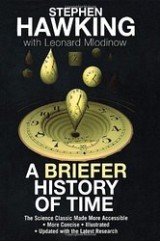(co-authored with Stephen Hawking)
Buy this book at Amazon, Barnes and Noble, IndieBound, or iBooks.
New York Times Bestseller
“Hawking and Mlodinow provide one of the most lucid discussions of this complex topic ever written for a general audience. . . . [They] maintain the same wry, lively tone that made A Brief History of Time such a delight.”—Publishers Weekly, starred review
“May be the clearest introduction to physics ever . . . An utterly engrossing read.”—Booklist
“Hawking and Mlodinow… proceed by small and careful steps from the early history of astronomy to today's efforts to construct a grand unified theory of the universe.” Scientific American
Stephen Hawking’s worldwide bestseller A Brief History of Time remains a landmark volume in scientific writing. But for readers who have asked for a more accessible formulation of its key concepts—the nature of space and time, the role of God in creation, and the history and future of the universe—A Briefer History of Time is the answer. Although “briefer,” this book is much more than a mere explanation of Hawking’s earlier work.
 A Briefer History of Time both clarifies and expands on the great subjects of the original, and records the latest developments in the field—from string theory to the search for a unified theory of all the forces of physics. Discussed at length are the mysterious dark matter and dark energy-both of which can only be observed by their gravitational effects and are believed to make up 90 percent of the universe, and string theory, interest in which has exploded in the past 20. Hawking and Mlodinow provide one of the most lucid discussions of this complex topic ever written for a general audience.
A Briefer History of Time both clarifies and expands on the great subjects of the original, and records the latest developments in the field—from string theory to the search for a unified theory of all the forces of physics. Discussed at length are the mysterious dark matter and dark energy-both of which can only be observed by their gravitational effects and are believed to make up 90 percent of the universe, and string theory, interest in which has exploded in the past 20. Hawking and Mlodinow provide one of the most lucid discussions of this complex topic ever written for a general audience.
Readers will come away with an excellent understanding of the apparent contradictions and conundrums at the forefront of contemporary physics. Recognizing that much of their audience will also be science fiction buffs, they include a chapter on the possibility of time travel. "Don't bet on it," the authors advise. Throughout these discussions, the authors maintain the same wry, lively tone that made the original Brief History such a delight. They close with a discussion of where physics ends and philosophy begins, "Why does the universe exist at all?" They cannot provide the answer, but they do provide an immense amount of food for thought. Thirty-seven full-color illustrations enhance the text and make A Briefer History of Time an exhilarating and must-have addition in its own right to the great literature of science and ideas.
